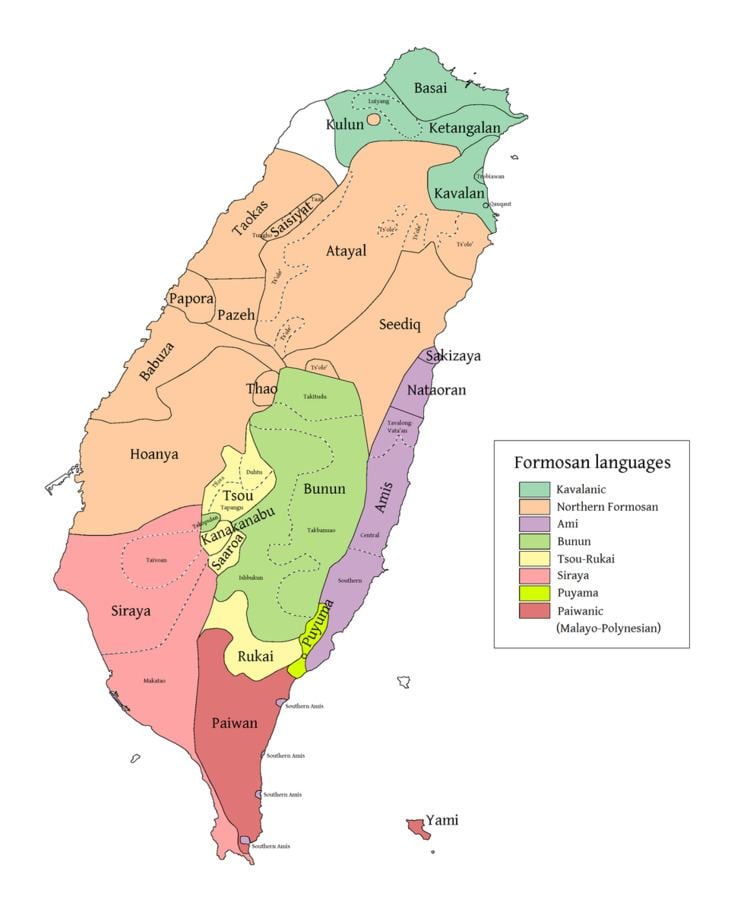Native speakers 38,000 (2002) | Ethnicity Bunun people Language family AustronesianBunun | |
 | ||
Dialects IsbukunNorth–Central (Takitudu–Takbanuao) | ||
The Bunun language (Chinese: 布農語) is spoken by the Bunun people of Taiwan. It is one of the Formosan languages, a geographic group of Austronesian languages, and is subdivided in five dialects: Isbukun, Takbunuaz, Takivatan, Takibaka and Takituduh. Isbukun, the dominant dialect, is mainly spoken in the south of Taiwan. Takbunuaz and Takivatan are mainly spoken in the center of the country. Takibaka and Takituduh both are northern dialects. A sixth dialect, Takipulan, became extinct in the 1970s.
Contents
The Saaroa and Kanakanabu, two smaller minority groups who share their territory with an Isbukun Bunun group, have also adopted Bunun as their vernacular.
Dialects
Li (1988) splits the Bunun dialects into 3 main branches — Northern, Central, and Isbukun (also classified as Southern Bunun). Isbukun, the prestige dialect, is also the most divergent dialect. The most conservative dialects are spoken in the north.
Bunun was originally spoken in and around Sinyi Township (Xinyi, 信義鄉) in Nantou County (De Busser 2009:63). From the 17th century onwards, the Bunun people expanded towards the south and east, absorbing other ethnic groups such as the Saaroa, Kanakanabu, and Thao. Bunun is spoken in an area stretching from Ren-ai Township (仁愛鄉) in Nantou in the north to Yan-ping Township (延平鄉) in Taitung in the south. Isbukun is distributed throughout Nantou, Taitung, and Kaohsiung. Takbanuað is spoken in Nantou and southern Hualien County. Takivatan is spoken in Nantou and central Hualien. Both Takituduh and Takibakha are spoken in Nantou.
Consonants
Orthographic notes:
Notes:
Vowels
Notes:
Overview
Bunun is a verb-initial language and has an Austronesian alignment system or focus system. This means that Bunun clauses do not have a nominative–accusative or absolutive–ergative alignment, but that arguments of a clause are ordered according to which participant in the event described by the verb is 'in focus'. In Bunun, four distinct roles can be in focus:
Which argument is in focus is indicated on the verb by a combination of prefixes and suffixes .
Many other languages with a focus system have different marking for patients, instruments and beneficiaries, but this is not the case in Bunun. The focussed argument in a Bunun clause will normally always occur immediately after the verb (e.g. in an actor-focus clause, the agent will appear before any other participant) and is in the Isbukun dialect marked with a post-nominal marker a.
Bunun has a very large class of auxiliary verbs. Concepts that are expressed by auxiliaries include:
In fact, Bunun auxiliaries express all sorts of concepts that in English would be expressed by adverbial phrases, with the exception of time and place, which are normally expressed with adverbial phrases.
Word classes
Takivatan Bunun has the following word classes (De Busser 2009:189). (Note: Words in open classes can be compounded, whereas those in closed classes cannot.)
- Nouns
- Verbs
- Adjectives
- Demonstratives
- Anaphoric pronouns
- Personal pronouns
- Numerals
- Place words
- Time words
- Manner words
- Question words
- Auxiliaries
Affixes
Bunun is morphologically agglutinative language and has a very elaborate set of derivational affixes (more than 200, which are mostly prefixes), most of which derive verbs from other word classes. Some of these prefixes are special in that they do not only occur in the verb they derive, but are also foreshadowed on a preceding auxiliary. These are called lexical prefixes or anticipatory prefixes and only occur in Bunun and a small number of other Formosan languages.
Below are some Takivatan Bunun verbal prefixes from De Busser (2009).
In short:
A more complete list of Bunun affixes from De Busser (2009) is given below.
Pronouns
Takivatan Bunun personal pronoun roots are (De Busser 2009:453):
The tables of Takivatan Bunun personal pronouns below are sourced from De Busser (2009:441).
Iskubun Bunun personal pronouns are somewhat different (De Busser 2009:454).
Demonstratives
Takivatan Bunun has the following demonstrative roots and affixes (De Busser 2009:454):
- Proximal: -i
- Medial: -un
- Distal: -a
- aip-: singular
- aiŋk-: vague plural
- aint-: paucal
- ait-: inclusive generic
- Ø-: visible
- n-: not visible
- ʔiti here
- ʔitun there (medial)
- ʔita there (distal)
Function words
Takivatan Bunun also has definitive markers.
